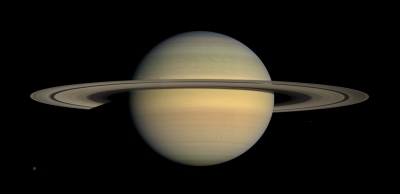The CassiniHuygens space-research mission ( k-SEE-nee HOY-gnz), commonly called Cassini, involved a collaboration among NASA, the European Space Agency (ESA), and the Italian Space Agency (ASI) to send a space probe to study the planet Saturn and its system, including its rings and natural satellites. The Flagship-class robotic spacecraft comprised both NASA's Cassini space probe and ESA's Huygens lander, which landed on Saturn's largest moon, Titan. Cassini was the fourth space probe to visit Saturn and the first to enter its orbit, where it stayed from 2004 to 2017. The two craft took their names from the astronomers Giovanni Cassini and Christiaan Huygens.
Launched aboard a Titan IVB/Centaur on October 15, 1997, Cassini was active in space for nearly 20 years, with 13 years spent orbiting Saturn and studying the planet and its system after entering orbit on July 1, 2004. The voyage to Saturn included flybys of Venus (April 1998 and July 1999), Earth (August 1999), the asteroid 2685 Masursky, and Jupiter (December 2000). The mission ended on September 15, 2017, when Cassini's trajectory took it into Saturn's upper atmosphere and it burned up in order to prevent any risk of contaminating Saturn's moons, which might have offered habitable environments to stowaway terrestrial microbes on the spacecraft. The mission was successful beyond expectations NASA's Planetary Science Division Director, Jim Green, described Cassini-Huygens as a "mission of firsts" that has revolutionized human understanding of the Saturn system, including its moons and rings, and our understanding of where life might be found in the Solar System.Cassini's planners originally scheduled a mission of four years, from June 2004 to May 2008. The mission was extended for another two years until September 2010, branded the Cassini Equinox Mission. The mission was extended a second and final time with the Cassini Solstice Mission, lasting another seven years until September 15, 2017, on which date Cassini was de-orbited to burn up in Saturn's upper atmosphere.
The Huygens module traveled with Cassini until its separation from the probe on December 25, 2004; Huygens landed by parachute on Titan on January 14, 2005. It returned data to Earth for around 90 minutes, using the orbiter as a relay. This was the first landing ever accomplished in the outer Solar System and the first landing on a moon other than Earth's Moon.
At the end of its mission, the Cassini spacecraft executed its "Grand Finale": a number of risky passes through the gaps between Saturn and Saturn's inner rings.
This phase aimed to maximize Cassini's scientific outcome before the spacecraft was intentionally destroyed to prevent potential contamination of Saturn's moons if Cassini were to unintentionally crash into them when maneuvering the probe was no longer possible due to power loss or other communication issues at the end of its operational lifespan. The atmospheric entry of Cassini ended the mission, but analysis of the returned data will continue for many years.
Saturn is the sixth planet from the Sun and the second-largest in the Solar System, after Jupiter. It is a gas giant with an average radius of about nine and a half times that of Earth. It only has one-eighth the average density of Earth; however, with its larger volume, Saturn is over 95 times more massive.Saturn's interior is most likely composed of a core of iron–nickel and rock (silicon and oxygen compounds). Its core is surrounded by a deep layer of metallic hydrogen, an intermediate layer of liquid hydrogen and liquid helium, and finally, a gaseous outer layer. Saturn has a pale yellow hue due to ammonia crystals in its upper atmosphere. An electrical current within the metallic hydrogen layer is thought to give rise to Saturn's planetary magnetic field, which is weaker than Earth's, but which has a magnetic moment 580 times that of Earth due to Saturn's larger size. Saturn's magnetic field strength is around one-twentieth of Jupiter's. The outer atmosphere is generally bland and lacking in contrast, although long-lived features can appear. Wind speeds on Saturn can reach 1,800 km/h (1,100 mph; 500 m/s), higher than on Jupiter but not as high as on Neptune.The planet's most notable feature is its prominent ring system, which is composed mainly of ice particles, with a smaller amount of rocky debris and dust. At least 83 moons are known to orbit Saturn, of which 53 are officially named; this does not include the hundreds of moonlets in its rings. Titan, Saturn's largest moon and the second largest in the Solar System, is larger than the planet Mercury, although less massive, and is the only moon in the Solar System to have a substantial atmosphere.

2004Jul, 1
Saturn orbit insertion of Cassini-Huygens begins at 01:12 UTC and ends at 02:48 UTC.
Choose Another Date
Events on 2004
- 1Jan
Pervez Musharraf
In a vote of confidence, General Pervez Musharraf wins 658 out of 1,170 votes in the Electoral College of Pakistan, and according to Article 41(8) of the Constitution of Pakistan, is "deemed to be elected" to the office of President until October 2007. - 2Feb
Roger Federer
Swiss tennis player Roger Federer becomes the No. 1 ranked men's singles player, a position he will hold for a record 237 weeks. - 1May
European Union
Cyprus, Czech Republic, Estonia, Hungary, Latvia, Lithuania, Malta, Poland, Slovakia, and Slovenia join the European Union, celebrated at the residence of the Irish President in Dublin. - 26May
Oklahoma City bombing
United States Army veteran Terry Nichols is found guilty of 161 state murder charges for helping carry out the Oklahoma City bombing. - 3Aug
September 11 attacks
The pedestal of the Statue of Liberty reopens after being closed since the September 11 attacks.

 English
English  español
español  français
français  português
português  русский
русский  العربية
العربية  简体中文
简体中文 